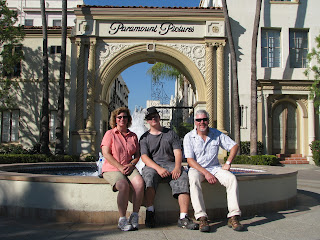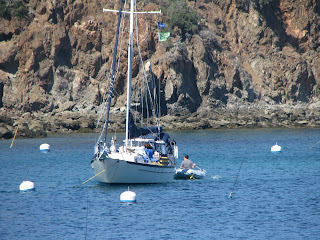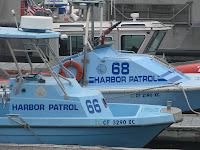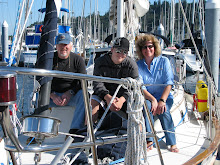Departed Monterey Bay fuel dock at 9:00AM and headed for Morro Bay (120 nm).
Westerly winds 15 knots at 10:30AM, increasing to 22 knots by 1:35 PM. We sailed at 6 knots or more on a beam reach with reduced sails. By 11:00PM the wind had died down and we started the engine. Alex made the crew a hearty soup. He combined a vegetable and pasta soup mix with spicy Italian sausage, it didn't last long and there were no complaints from the crew. Later, Alex baked chocolate chip cookies for desert. The sugar must have energized Alex because he offered to take my 12-3:00AM watch and worked on his algebra homework while he kept watch.
Our B&G auto pilot began to spontaneously switch to standby mode after a few hours of working.
This caused the crew to resort to manual steering during each watch. After shutting off the autopilot for an hours or two it usually works fine for an hour or two, then it switches itself to standby mode again and the crew is obliged to steer by hand again. This caused Alex much frustration while he was trying to do his homework and keep watch in the wee hours of the morning.
Fuel consumption is something that we’ve been calculating every time the fuel tank is filled. We carry 45-50 gallons of fuel in the fuel tank, plus 30 gallons in six jerry cans lashed to the stanchions:
75 gallons in all. So far the longest leg of our cruise has been from Grays Harbor, Washington to San Francisco, CA, approximately 750 nautical miles.
By the time we arrived at San Francisco we had about 25 gals of fuel remaining. We motored through calms at the beginning and end of that leg, and motored again during the storm after our staysail hanks failed.
As best we can calculate we are getting between 0.87 and 0.75 gals per hour, or 7 to 8 nautical miles per gallon at 6 knots.
Our 75 gallon fuel supply will take us about 500 – 600 nautical miles, however, not wanting to drain the tank dry a practical range of 450 miles.
We arrived at the sea buoy at the entrance of Morro Bay at 8:00 AM, visibility was limited to about 100 yards due to the fog. I steered the boat to the south side of the entrance and turned north at the 30-foot contour to find the red buoy that marked the entrance.
After calling a “securitay” on channel 16 we proceeded into the outer harbor. The fog made navigation from buoy to buoy not possible and a strong flood current cause me to head back out until current slackened and visibility improved. I called a second “securitay” to inform other boats that we were standing off at the sea buoy until conditions improved.
The swells were already 6-8 feet high as we headed back out. Morro Bay Harbor Patrol responded right away, saying, “
if you’d like we’ll meet you at the sea buoy in 5 minutes to escort you in, the flood tide is late but it’s nearly over and you’d be better off coming in now than after the start of ebb tide”. I accepted their offer and thanked them. In a few minutes we could see a blue patrol boat coming our way. They asked us where we were planning on mooring, I said “
we’re headed for the Morro Bay Yacht Club”, and the patrol boat led us right to their front door.
Bill commented that Morro Bay looks more like the Swanomish Slew near La Conner, Washington than any place in California. I agreed saying that if you had just materialized here without knowing where you were you'd never guess that you were in California.
I asked the harbormaster at the yacht club when the fog will lift: yesterday was his answer. We rafted up to one boat at the dock, but moved to another spot at the end of the dock that had just opened up. While the crew took a well-earned nap, a sail boat operated by a young fellow rafted up to us. He offered a six-pack for the inconvenience of his arrival but I declined, saying it was not necessary. The skipper Brennan and his crew of two young ladies are headed south. Of the three other sailboats at the dock, two were participating in the Baja Ha Ha. We’ve been seeing more boats with the familiar green pennant the farther south we get. Though, Brennan and crew are not joining the Ha-Ha, I’m sure will bump into them again, somewhere down the line.
Morro Bay provides more than a safe harbor for sailors cruising the west coast, its rural character provides a place where you can rest and enjoy the first silence in many days. Here the wind doesn't blow the halyards into a rat-a-tat against your mast, sea lions don't wake you with their constant barking, music doesn't blare from your neighbor's boat, and you barely hear a car or truck go by. The quiet is something you'll notice right away, and its delightful.














































